The following suggestion is based on an answer of mine from a previous post.
You can solve your problem by merging both of your series and storing them in pandas dataframe. Then you can use any desired technique to identify and remove outliers. Take a look at the post mentioned above.
Here is my take on your particular problem using a snippet that can handle more than one series:
Since I don't have access to your data, the following snippet will produce two series where one of them has a distinctive outlier:
def sample(colname):
base = 100
nsample = 20
sigma = 10
# Basic df with trend and sinus seasonality
trend1 = np.linspace(0,1, nsample)
y1 = np.sin(trend1)
dates = pd.date_range(pd.datetime(2016, 1, 1).strftime('%Y-%m-%d'), periods=nsample).tolist()
df = pd.DataFrame({'dates':dates, 'trend1':trend1, 'y1':y1})
df = df.set_index(['dates'])
df.index = pd.to_datetime(df.index)
# Gaussian Noise with amplitude sigma
df['y2'] = sigma * np.random.normal(size=nsample)
df['y3'] = df['y2'] + base + (np.sin(trend1))
df['trend2'] = 1/(np.cos(trend1)/1.05)
df['y4'] = df['y3'] * df['trend2']
df=df['y4'].to_frame()
df.columns = [colname]
return(df)
df_sample1 = sample(colname = 'series1')
df_sample2 = sample(colname = 'series2')
df_sample2['series2'].iloc[10] = 800
df_sample1.plot()
df_sample2.plot()
Series 1 - No outliers

Series 2 - A distinctive outlier

Now you can merge those series like this:
# Merge dataframes
df_merged = pd.merge(df_sample1, df_sample2, how='outer', left_index=True, right_index=True)
df_merged.plot()

What is considered an outlier will depend full on the nature of your dataset. In this case, you can set the level for identifying outliers using sscipy.zscore(). In the following case, every observation with a difference that exceeds 3 is considered an outlier.
# A function for removing outliers
def noSpikes(df, level, keepFirst):
# 1. Get some info about the original data:
##%%
#df = df_merged
#level = 3
#keepFirst = True
##%%
firstVal = df[:1]
colNames = df.columns
colNumber = len(df.columns)
#cleanBy = 'Series1'
# 2. Take the first difference and
df_diff = df.diff()
# 3. Remove missing values
df_clean = df_diff.dropna()
# 4. Select a level for a Z-score to identify and remove outliers
df_Z = df_clean[(np.abs(stats.zscore(df_clean)) < level).all(axis=1)]
ix_keep = df_Z.index
# 5. Subset the raw dataframe with the indexes you'd like to keep
df_keep = df.loc[ix_keep]
# 6.
# df_keep will be missing some indexes.
# Do the following if you'd like to keep those indexes
# and, for example, fill missing values with the previous values
df_out = pd.merge(df_keep, df, how='outer', left_index=True, right_index=True)
# 7. Keep only the original columns (drop the diffs)
df_out = df_out.ix[:,:colNumber]
# 8. Fill missing values
df_complete = df_out.fillna(axis=0, method='ffill')
# 9. Reset column names
df_complete.columns = colNames
# Keep the first value
if keepFirst:
df_complete.iloc[0] = firstVal.iloc[0]
return(df_complete)
df_clean = noSpikes(df = df_merged, level = 3, keepFirst = True)
df_clean.plot()

Let me know how this works out for you.
Here's the whole thing for an easy copy-paste:
# Imports
import matplotlib.pyplot as plt
import pandas as pd
import numpy as np
from scipy import stats
np.random.seed(22)
# A function for noisy data with a trend element
def sample(colname):
base = 100
nsample = 20
sigma = 10
# Basic df with trend and sinus seasonality
trend1 = np.linspace(0,1, nsample)
y1 = np.sin(trend1)
dates = pd.date_range(pd.datetime(2016, 1, 1).strftime('%Y-%m-%d'), periods=nsample).tolist()
df = pd.DataFrame({'dates':dates, 'trend1':trend1, 'y1':y1})
df = df.set_index(['dates'])
df.index = pd.to_datetime(df.index)
# Gaussian Noise with amplitude sigma
df['y2'] = sigma * np.random.normal(size=nsample)
df['y3'] = df['y2'] + base + (np.sin(trend1))
df['trend2'] = 1/(np.cos(trend1)/1.05)
df['y4'] = df['y3'] * df['trend2']
df=df['y4'].to_frame()
df.columns = [colname]
return(df)
df_sample1 = sample(colname = 'series1')
df_sample2 = sample(colname = 'series2')
df_sample2['series2'].iloc[10] = 800
df_sample1.plot()
df_sample2.plot()
# Merge dataframes
df_merged = pd.merge(df_sample1, df_sample2, how='outer', left_index=True, right_index=True)
df_merged.plot()
# A function for removing outliers
def noSpikes(df, level, keepFirst):
# 1. Get some info about the original data:
firstVal = df[:1]
colNames = df.columns
colNumber = len(df.columns)
#cleanBy = 'Series1'
# 2. Take the first difference and
df_diff = df.diff()
# 3. Remove missing values
df_clean = df_diff.dropna()
# 4. Select a level for a Z-score to identify and remove outliers
df_Z = df_clean[(np.abs(stats.zscore(df_clean)) < level).all(axis=1)]
ix_keep = df_Z.index
# 5. Subset the raw dataframe with the indexes you'd like to keep
df_keep = df.loc[ix_keep]
# 6.
# df_keep will be missing some indexes.
# Do the following if you'd like to keep those indexes
# and, for example, fill missing values with the previous values
df_out = pd.merge(df_keep, df, how='outer', left_index=True, right_index=True)
# 7. Keep only the original columns (drop the diffs)
df_out = df_out.ix[:,:colNumber]
# 8. Fill missing values
df_complete = df_out.fillna(axis=0, method='ffill')
# 9. Reset column names
df_complete.columns = colNames
# Keep the first value
if keepFirst:
df_complete.iloc[0] = firstVal.iloc[0]
return(df_complete)
df_clean = noSpikes(df = df_merged, level = 3, keepFirst = True)
df_clean.plot()



